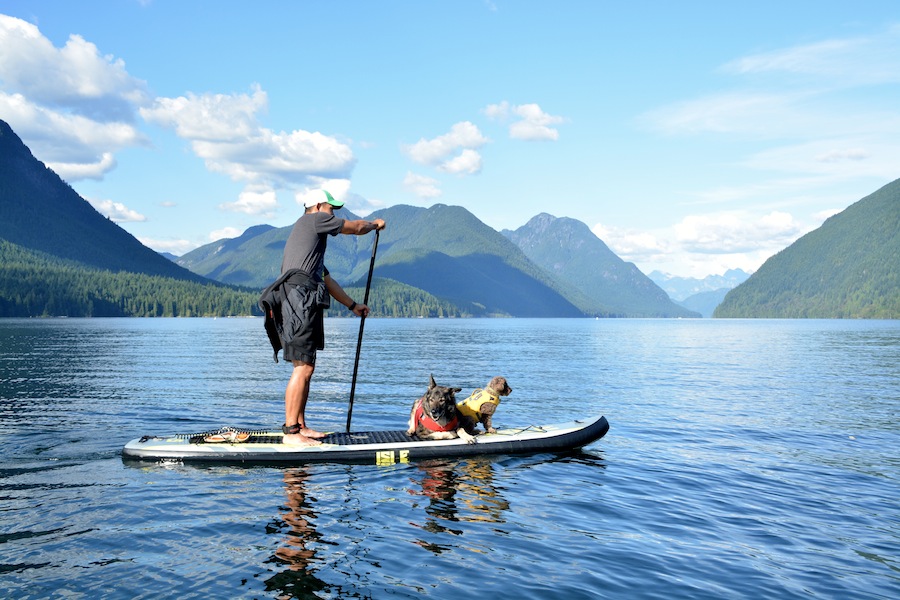
Taking your dog out stand-up paddle boarding with you can be an awesome outdoor adventure for both you and your pup.
The trick to making it a fun and rewarding experience is to train your dog well before he ever gets on the water.
When I adopted my dog Seth I knew I wanted to share my love of stand-up paddling with him. It was important to me that he not only wanted to come out on the water but enjoyed the experience as well.
Thankfully he is the personality type to be up for any adventure and he doesn’t like to be left behind so he was a natural at stand-up paddling. However I spent some time getting him ready and training him before ever getting on the water.
I started right away getting him accustomed to my board and getting him comfortable just being on the paddle board.
In a very short period of time Seth became a SUP pro! The 5 steps below are a good guide to follow and worked really well for us.
5 Step Guide
1. Keep your board in the house for a week in an area your dog is comfortable.
The point of this is to help your dog get used to the board and for him to see it as a fun and safe thing that he doesn’t need to be afraid of.
Let your dog explore the board on his own at first. He will probably sniff it all over and may or may not try to walk on it.
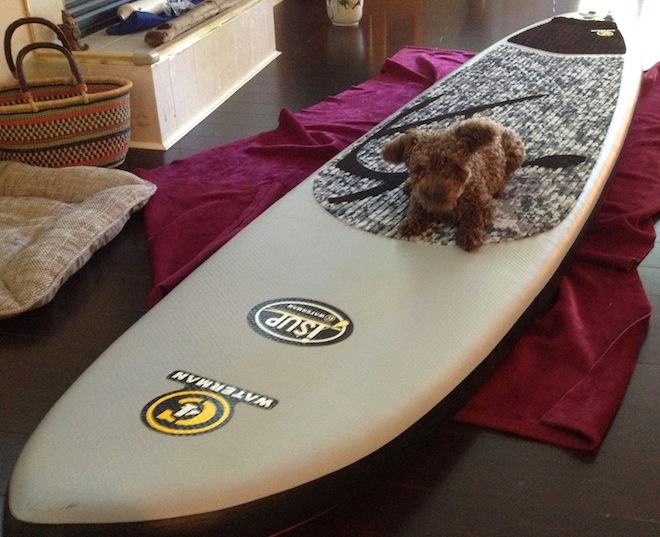
2. Place a treat on the board.
After a day or so of this place a treat on the board so that your dog must walk on it in order to get it.
Once he’s on the board give him another treat. Ask him to sit, give another treat.
Do this periodically throughout the day. If your dog still seems uncomfortable then take the process a little slower.
If your dog easily gets on the board for his treat continue on.
My dog got the message very quickly… He understood that when he sat on the board he got a treat. Suddenly your paddle board is looking pretty good to him as it has been a rewarding experience so far.
Always keep the energy light and make the board a fun place. If he’s having trouble with this process just take it slow and allow him to get fully comfortable before moving on to the next step.
Once your dog is comfortable sitting on the board on his own, practice with his PFD on so that he learns to associate the lifejacket with the whole process.
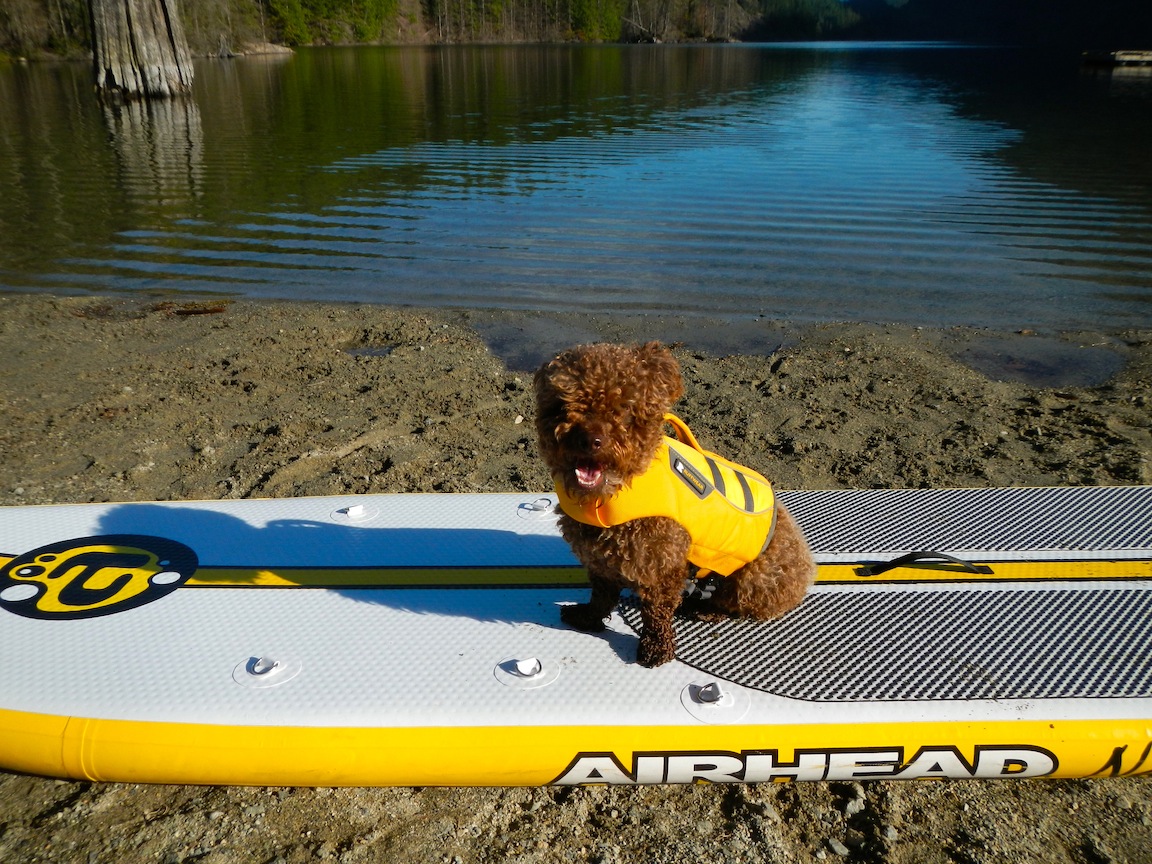
Seth needed a haircut in this pic, can’t even see his eyes!
3. Have special commands for getting off and on the board.
Having a special command for getting on and off the board during this process is quite important.
If your dog should jump off the board because he sees a duck while you are paddling in the water, he may throw you overboard as well.
Give your dog a special command for getting on the board to get his treat.
Then make sure you give another special command when you ask your dog to get off. Each time he gets a treat when this is done properly.
If your dog jumps off the board before you have given the command then there is no treat.
Ask your dog to get back on, sit, and stay. Then give the command to get off. Overtime you will be able to lengthen the amount of time he stays on the board before asking him to get off.
4. Practice sitting, standing and paddling on the board with your dog.
Once your dog is comfortable sitting on the board in the right spot by himself now you can practice sitting and standing on the board with him.
Ask your dog to get on the board and sit in his spot. Then sit on the board behind your dog. Give him another treat when he stays in place with you sitting behind him.
When he is comfortable with that try standing and rocking back and forth a bit.
Some dogs are better with this than others, so if your pup is having trouble, just take it slow and go back a step if you need to.
Try to keep the environment positive and rewarding as opposed to setting him up for failure.
Once he is comfortable with this step you can practice the paddling stroke with your SUP paddle while standing to get your dog used to the paddle moving around him.
5. Head to the water.
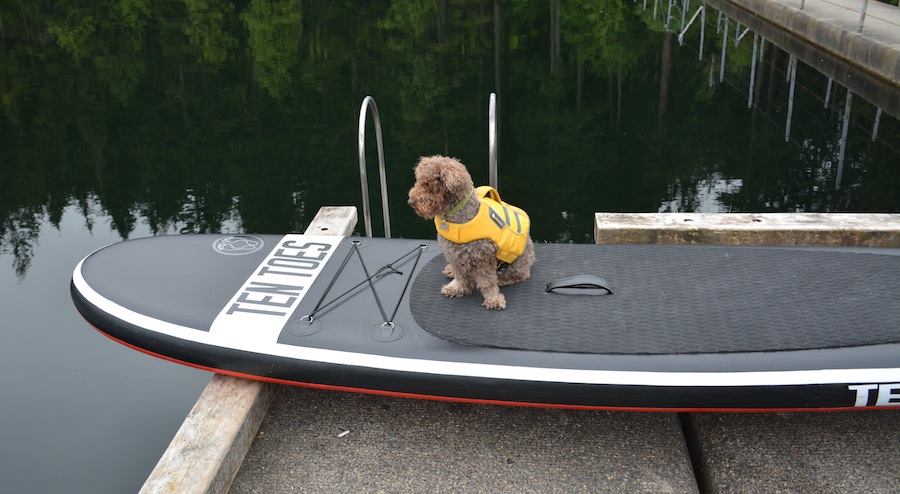
Next take your dog to the water with the board and practice the same steps with the board close to the water or slightly on the water.
Go through each step to make sure he responds the same way in a different environment.
Depending on your dog’s nature you may need to practice this a few times before you ever actual get on the water.
Seth is so used to our routine that I am often still getting ready and find him sitting patiently on my board waiting to launch.
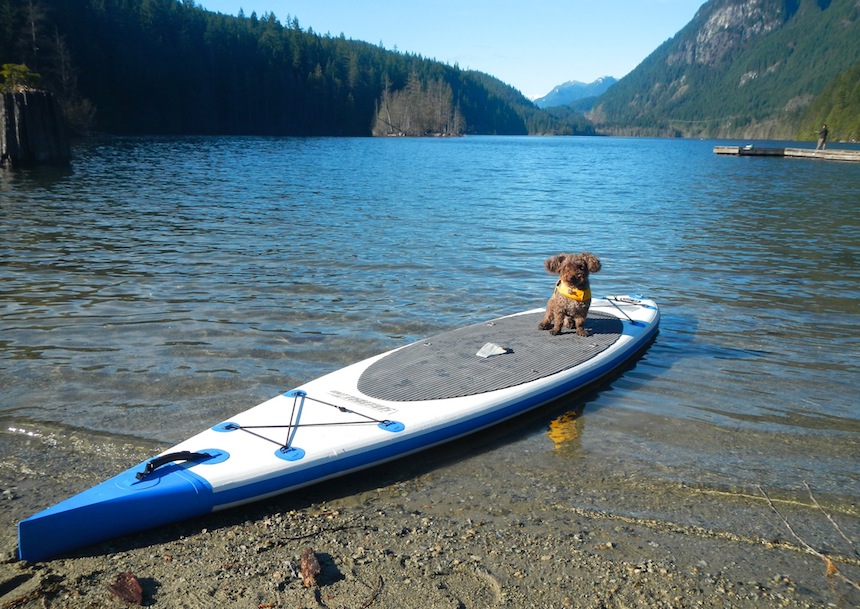
When your dog feels comfortable and confident give it a shot. Keep your first outing short and give your dog lots of praise when you are done.
Expect a few mistakes and possibly a few wet tumbles.
However once your dog gets it the experience is truly awesome. Seth and I have paddled everywhere together from beautiful mountain lakes, to meandering rivers, to taking on some serious ocean chop.
He’s not fond of crashing through heavy waves but with his doggles on he tolerates the spray and handles it like a champ.

In his element!
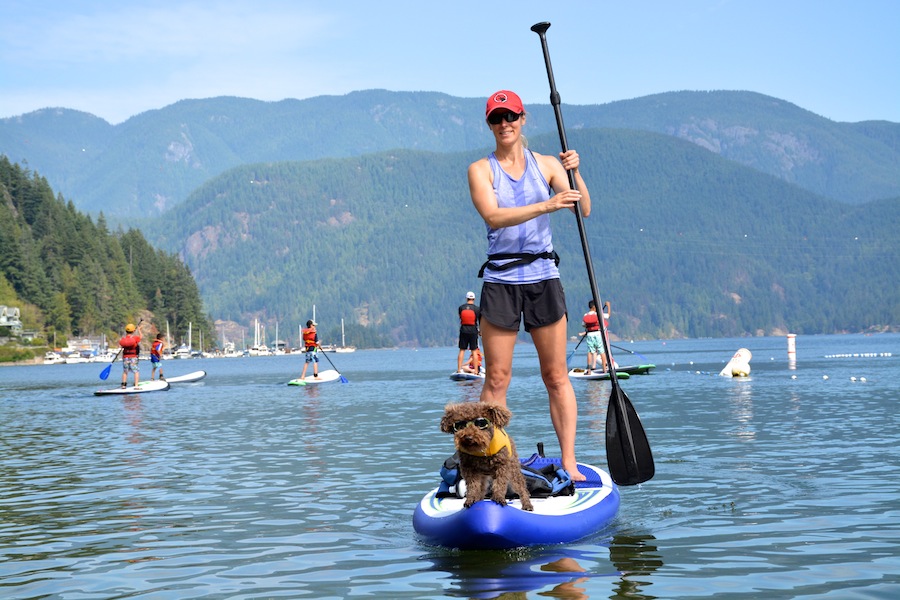
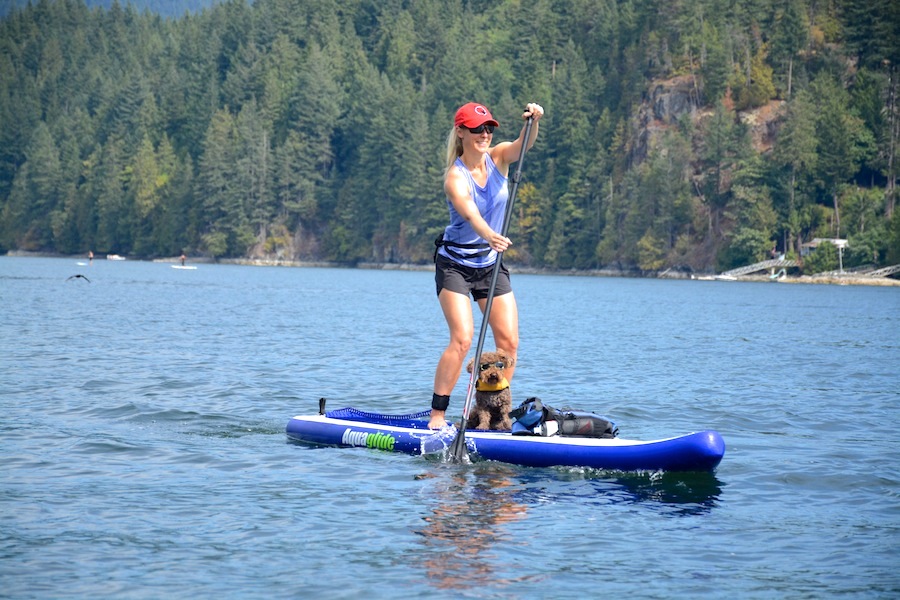
Safety Precautions
- It is highly recommended that your dog wear a PFD while stand-up paddling. This will ensure that your dog is safe should he fall or jump in the water or hit his head. Ideally his PFD should have a handle on top. The handle is critical to help lift your dog back on the board should he fall or go in for a swim. I really like the Ruffwear Float Coat. It has a great fit, is easily adjustable and super durable. Seth has been using this PFD for 7 years now and it’s still as good as new.
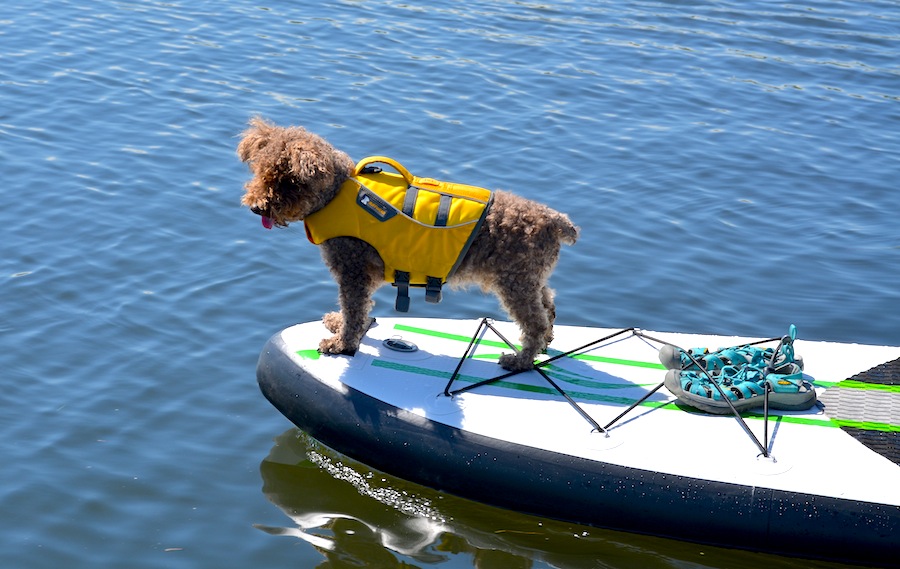
- It is also highly recommended that you never keep your dog hooked to a leash while paddling. If your dog should end up in the water accidentally the leash could strangle him. Train your dog before getting on the board so that the leash is not necessary.
- If your dog is scared of water then that will be your first obstacle to overcome before ever getting on the board. That being said Seth does not like to swim. He jumped off once, realized it meant he would have to swim and has never jumped off again. So it could possibly work in your favour too!
When Training Goes Out The Window
With Seth I followed these steps closely and consequently I feel he is a very confident rider on my stand-up paddle board and he absolutely loves to come out with me.
He will board hop when paddling with friends as he likes to take a turn with everyone. These steps worked really well for him.
A little while after Seth came into my life I ended up with a boyfriend who had an older German Shepard named Oscar who LOVES to swim and we weren’t sure he would ever stay on a board long enough to be able to paddle with us.
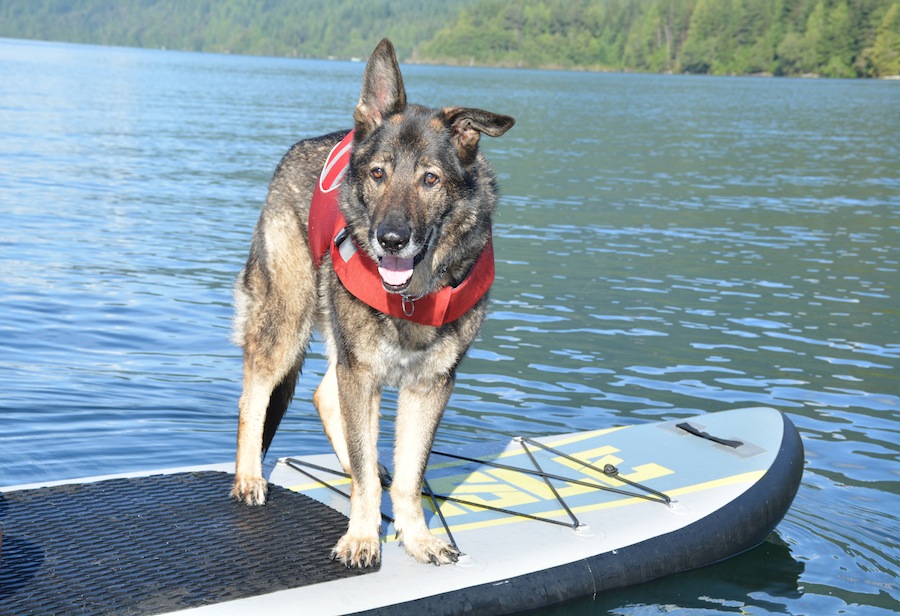
As we became a family leaving Oscar behind when heading out on our paddling adventures was not an option.
We finally decided to give it a go with Oscar on a whim while on a road trip. We literally skipped each one of these steps and just went for it.
We started with him in a kayak as we thought that might be an easier transition. Then got him on a board. As you can imagine paddling with a 75 lbs. German Shepard is a lot different than paddling with a 13 lbs. Doodle!
It was not as smooth of a learning curve however Oscar did surprisingly well and as long as he got rewarded with a swim at some point during or after the paddle, he was a very happy boy to be along for the ride.
It took a little time for him to get fully confident and to lose the ‘shaky legs’. However he endured and impressed us with his resolve to master this new skill. We feel blessed that he is able to come with us and enjoy paddling in his senior years.
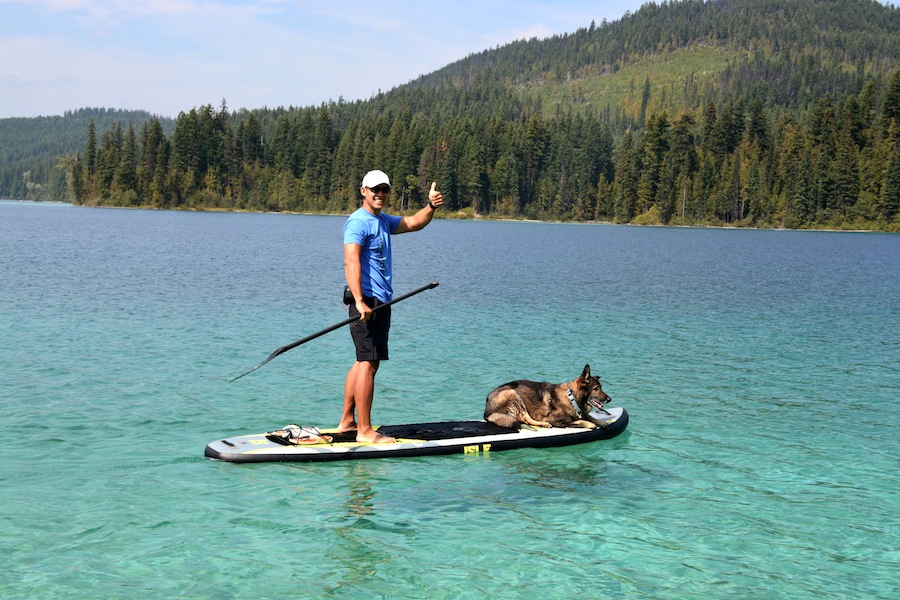
This was Oscar’s second day on our board. We didn’t have his PFD yet.
So I guess sometimes depending on your dogs personality you just have to go for it. I would just caution to make sure there are lots of rewards. The last thing you want is for it to be such a scary and bad experience that he never wants to go near your board again.
You can read more about Oscar’s paddling experience in our post “Teaching An Old Dog New Tricks”.
Inflatable Paddle Boards Are Perfect For Dogs
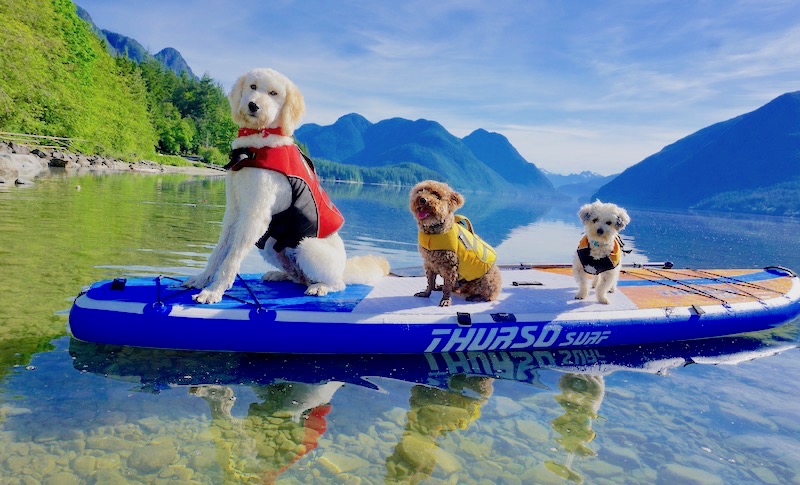
Inflatable SUP’s tend to be ideal for paddling with a dog. They provide great traction for their paws and are quite stable.
I often get questions about whether their claws can damage the boards. The answer is no they don’t.
I have never had any damage whatsoever to any of my inflatable boards from the dogs claws so not to worry.
We have compiled a list of the Best SUPs For Paddling With Dogs that you might find helpful in order to choose a board that will suit your needs and your dogs needs best.
Good luck and happy paddling!!
 The Growing Sport of Stand Up Paddling
The Growing Sport of Stand Up Paddling Seth The Pup Who Loves To SUP
Seth The Pup Who Loves To SUP Health Benefits Of Stand Up Paddle Boarding
Health Benefits Of Stand Up Paddle Boarding Stand-Up Paddling And Kids
Stand-Up Paddling And Kids





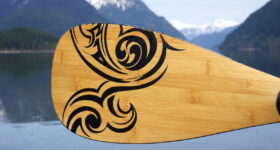
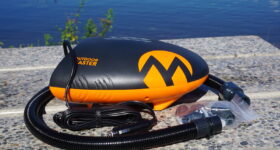
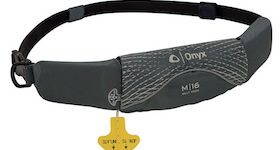
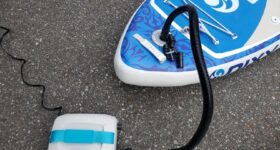
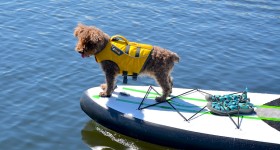

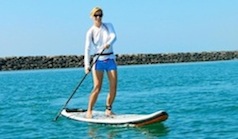
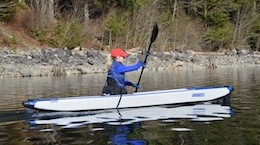
Can I ask what commands you’d recommend using for getting on and off the board?
Hey there, thank you for the article.
I took my pup out yesterday for the first time. He seems to really like the water but whenever I give him the command to stay on the board, he cries NONSTOP and seems a little frantic. When I let him jump into the water, his only objective in life is grabbing wrist straps from my neighbor’s boards and either bringing it to them or to me. I’m a little confused. He’s never had an interest in fetch or even toys, really. I tried to see if I could observe a trend in his actions to figure out what it was that he wanted but his actions honestly seemed pretty random. He wears his PFD and the only reason I’m worried is he’ll continue to swim even when he’s tired. We do have a puppy at home that he’s quite bonded with–so I wonder if he’s looking for her since she stayed back at the house? I’m not sure, but nothing I do consoles him when he’s on the board, he’ll cry the whole ride.
Hey Macy, Oh man that sounds really tough! It’s so hard to say what’s gong through their head isn’t it! Did you try any training at home on the board? I would definitely try and get your dog used to the board at home first to make it a positive experience. Then take really slow steps, maybe go to the beach with the board but don’t go on the water yet, just try getting your dog used to the board at the shore. Then try placing your dog on the board in the water but right next to shore and let him float there for a bit. Offer lots of treats for positive behaviour. Move the board around a bit but don’t actually paddle. It might take a few times before you can paddle anywhere for him to feel comfortable. Sounds like it’s going to take a bit of patience. Good luck, I really hope it works out for the both of you!
Hi i want to start paddle boarding with my irish setter x goldendoodle dog this year he’s 1 year old and quite an excited pup! I was wondering if it would be better if i teach him how to walk off leash before? Because if he’s outside he’s always on a leash and I’m scared that he might get distracted by something outside and try to chase after it
Your pup sounds awesome, that’s an interesting combination, must be adorable! It certainly wouldn’t hurt for your pup to have some good training beforehand but honestly my dogs aren’t great at walking off leash in certain areas. I often keep them on leash until we get on the water unless we’re at an off leash beach area. With regards to excitement when you are on the water it can take a bit of time to work with that. My newest dog is very excitable and adventurous. She’s CRAZY for ducks and loves the water so she doesn’t think twice about leaping off my board to swim towards them… It’s been interesting lol. I have been paddling with her in calmer areas where there isn’t a lot of action going on and trying to train her with treats. Also I find it helps if you can walk your dog well before getting on the board to get rid of some of that energy. When just starting out do very short paddles with your dog. My friend was training her 1 year old Goldendoodle to go paddle boarding with her and found that her dog would get restless after about 20 minutes, it took a bit of time to work up to longer paddles. Plus it helps to reward them afterwards with either a swim, walk or some play time. Good luck, I hope it goes well! Start slowly and be sure to reward your dog well for sitting still on the board. 🙂
Hi, great article! I have been paddleboarding for two summers now and just added two pups to my family and would like to introduce them to it. They are 1.5 yr old sisters about 70 ish lbs each. Currently I have a yoga board that could just take the weight of me and one of them, so I want to try them out individually before trading in my board for a bigger one that may take all three of us just in case they just don’t like boarding! Just wondering where is the best placement for one dog on the board? Below you, just in front of you or right at the front of the board? What about two dogs? And if you both fall in, is it best for you or your dog to get back on first? Also, I notice here the comments begin back in 2014 so you probably wrote this article a while ago, any updates you would share since then on training or board type/brand? Thanks very much!
Hey Alison, True the article was written a few ago but I have been updating it as time goes on. I’ll go through it again and see if I need to make any changes. I am just reviewing a board right now that is designed for paddling with larger dogs and heavier loads so I’ll add it to the list!
First thing if you all fall off I would suggest you get back on the board first then help your dogs back on. Hopefully they have a lifejacket with a handle as that will make it much easier to help them back up.
Paddling with two 70 lbs. pups is going to be interesting, I think that’s so awesome! With two large dogs the best weight distribution will be if one is closer to the front and one is closer to the back with you in the middle. I find it harder to paddle with a dog too close to me at the center of the board so try and get one to sit or lay down about 3/4 of the way up the front of the board. Then the other can be about 3/4 of the way back.
You could also experiment with both at the front and you a little closer to the back. I’ve done that position and it can work ok as well. However sometimes they just end up where they end up and as long as they stay still it’s all good! 🙂
For paddling with only one dog I personally prefer the dog closer to the front with you in the middle or maybe just slightly back from the middle. That has always worked best for me.
Hope it works out! I’d LOVE to see a pic of your dogs on the board with you!
Hi, I’m 13 and I believe my mom’s going to let me foster a dog this summer! I love paddle boarding I’ve been doing it for a few years, but have never paddle boarded with a dog. I was wondering if even though I’m a little younger, if I would still be able to learn how to paddle board with a dog. I wouldn’t be out alone in the water I have an older sister who paddle boards with me. I sometimes prefer to sit when I’m paddle boarding, would that be okay with a dog? Thank you
Hi Kate, Fostering a dog for the summer sounds super exciting! You could definitely learn to paddleboard with a dog, it might just take a little bit of patience and training to make sure the dog is comfortable. Easiest way to start is to stay on your knees until the dog seems comfortable and relaxed – or sit that would definitely work too. The dog might be unsure of the movement of the paddle and the wobbliness of the board so it helps to do a little training at home first to get them used to it without being on water yet. I find it a lot easier to paddle with a smaller dog than a large dog but worth the effort as it’s so much fun!! With a big dog it’s really important that they sit and stay in one spot on the board and don’t move around. Bringing treats will help. Good luck, I hope it works out for you! 🙂
What a great article. I’m trying to teach my water loving lab/chessie to sup and Im wondering how to I prevent myself from falling when he wants to jump in the water?
Thank you much
It’s a tough one when your dog loves to be in the water. With Oscar our German Shepard I had to teach him that he was not allowed to jump off the board until I said so… And at that point I would get down on my knees to brace for the jump. However he didn’t really jump, he would kind of slither himself off the board, so it wasn’t too bad. If your dog wants to take a leap into the water I imagine it will be more difficult. I think your best option is to try and teach him to only jump when you give the command and make sure you are on your knees as opposed to standing – probably easier said than done. 🙂 Good luck!!
Thanks for the tips, I read this blog about a year ago before purchasing an SUP. Last summer I purchased an inflatable SUP and now that I have my “paddle legs,” I decided this summer to add my pups. I have two 90+ pound labs and they both love water so I just went for it. They have had a lot of training so the whole idea of sit, stay, etc was fine. They each did great but my only issue is after awhile they get tired and even the handle on the back of their pfd makes it hard to get them back on the board. We may be out for a few hours at a time so I like to give them time to swim, fetch and cool off from the Texas heat. The later in the trip however the more tired we all are and the more difficult it gets to get their back half on the board. I’ve scoured the internet looking for any ideas but haven’t found anything. Do you have any experience with this?
Hey Michelle, Love the idea of your two big labs on your paddle board! That’s a tough one, I also find it takes a lot of strength to get my 75 lbs. German Shepard back on the board. My boyfriend Darryl is much better at it than I am. My solution is usually if I can get to a shoreline at some point during my paddle I will let him jump off and swim to the shore and follow my board as I paddle in. From there I will play from the shoreline for a bit, throw sticks in the water, let him swim around, etc. Then I can more easily get him back on the board from the shoreline and continue on our paddle. Although there are times that I have to get him back on the board from the water and just muscle through it. It’s not easy and I imagine with two 90+ lb dogs it is way harder! Sorry I don’t have a better solution!
Thanks, that is helpful, I appreciate it. I have been looking at some of the helper harnesses they have for older dogs that allow you to lift around their rear hips. I may play with one of those to see if it can be worn with their pfd and not have too many straps or other things that can get tangled. I suppose I’ll have to work on getting in better shape in the meantime. Thank you for your inspiration and sharing your experiences. I firmly believe every dog should have a chance to do something adventurous and I love that you are encouraging people to try this with their pups.
Excellent article!!! I have an 11 ft. Atoll Board, and a 95 lb. GSD. I’ve collected all the gear for Kody, just haven’t taken the final step – training. Kody loves Agility training, so I hope he’ll love suping too!
That’s so awesome!! Both my little dogs did agility as well. I think it really helped with suping. Have fun and if you get any great pics with Kody on the board that you don’t mind sharing we’d love to see them!!
Thank you so much for your tips! I have a 12 year-old lab mix who loves the water. She definitely was a little nervous about getting up on the board but with a little bit of patience and a lot of treats Mia got the hang of climbing up on the board and waiting until I told her to get off. She loved her first trip around the lake so much she didn’t want to get off the board when we got back home. I can’t wait to go out with her again!
Yay that is so awesome! Way to go Mia!! I’m so glad you found the article helpful. I think it is particularly great for older dogs as they can just chill on the board but still be included in the fun activity. Oscar my German Shepherd is almost 14 now and he is really slowing down but he still gets SO excited to go paddling with us. Makes us all happy 🙂 . Happy paddling to you both!!
I have two large dogs and was thinking of buying a paddleboard for them to pull behind my kayak….thoughts on this?
Hey Darrell, You’ll have your work cut our for you pulling two big dogs but I love this idea! If you can train your dogs to sit still on the board or relax and lie down that would work great. Please send us pictures if you do! I might just try this myself 🙂
Congrats to all who paddle with their Best Friend. Check out my SUP step.
Bill @ BTO
http://www.bigtreeoutdoors.com
Hi, I am looking for a pull-behind dog vessel. My 100lb lab loves to SUP but he weighs me down too much and cramps my style. I’d like to consider a separate unit that pulls behind my sup. Any ideas on these? Anyone know an inventor?
Di
Never heard of a separate unit specifically for this but it’s a great idea. It would certainly be a good workout pulling your 100lb. lab!
Hi! I am looking to start working with my 1 year old German Shorthaired Pointer to be able to paddle board with me. What board would you suggest? I already have a 6′ board… Is that too short for an adult GSP? Would it be easier on a longer board?
Hey Jessica, A longer board would definitely be easier but you don’t have to go super long. We find that 10′- 11′ works well when paddling with our German Shepard Oscar. I particularly like the comfort level of an 11′ long board. It provides decent room for Oscar to lay day and keeps the weight distribution a little more balanced. 11′ long and 6″ thick works really well. There are quite a few options just depends on your budget. The Isle Explorer is a popular option for paddling with dogs. It is priced fairly well, has great accessories and is quite stable. We find it a little on the slow side but all things considered it’s a great board for the price. The 11′ Sea Eagle Longboard is another favorite of ours while paddling with Oscar. It is a little leaner than the Isle Explorer so is able to glide faster and turn easier but it will also be slightly less stable. However we found it only took us a couple outings with Oscar to feel quite comfortable paddling this SUP with him. Hope that helps. Let me know if you have any further questions!
Hi, I have been reading review after review on your site and really appreciate your insights! I am (almost) ready to choose a board and am certainly looking forward to getting out there with my 80 lb dog. I am wondering though, with the bigger dogs in a PFD, if they jump or fall off, how exactly do they get back up onto the board? I can’t imagine that I would be able to pull him up onto the board without falling in also and I am not sure that he would be able to crawl back on from inside the water. Am I overthinking this?
Hi Anna, No not overthinking it’s a really good question. Make sure your dogs PFD has a handle on it. Oscar (our 75 lbs. German Shepard) loves to swim so when we have him out on the board he always ends up in the water eventually whether he slips off or dives in. He can’t get back on by himself, however with the handle on his PFD I can help him get up. It’s a little tricky and takes a bit of effort but totally doable. Get onto your hands and knees and essentially just pull him back up. Between you pulling him up and your dog scrambling to climb on it will work. It’s not graceful haha, but I’ve never ended up in the water. You will end up wet after your dog shakes all the water off though 🙂
Practice on calm flat water close to shore where you feel safe first just to get the hang of it. Have fun and happy paddling!!
Thanks for sharing your SUP adventure! Love your pup.
I would appreciate reccomndations on a good board. My boy is good size, a bit long and lanky. He weighs about 70lbs, loves the water and loves to paddle.
Is there a good site that offers reviews and talks about the best purpose of the different models? I can’t seem to find anything.
Thanks for your help.
There are a few models I would recommend for a 70 lbs. dog. We have had good success with the Isle Explorer with our 75 lbs. German Shepard. It’s not the fastest board out there but it is stable and has decent room for the dog. Lately we have been using the Lokahi WE with our dogs as well. It is only 5″ thick (as opposed to 6″) so is quite responsive and is wide enough to provide good stability. However if your dog is good at paddle boarding already and you want a board that is versatile and that still glides nicely in the water I would say take a look at the Sea Eagle Longboard. We were initially using the wider boards with our German Shepard but now that he is good at laying still on the board and used to paddling with us we have found that the SE Longboard works really well. We have the 12’6″ long one and find that the extra length is really nice to have when sharing with a big dog plus this board is not as sluggish as the other two. It is not as wide as the others mentioned but it is 6″ thick making it fairly stable and very rigid. It can be used for flat water paddling as well as ocean touring and a little surf, it’s quite versatile. Hope that helps!
What would you recommend for a 45lb border collie mix & handler SUP newbie that is good in size and features & price? Thanks & appreciate you sharing the pics & tips esp for newbies.
The Isle Explorer would definitely be a good option. It is nice and stable and the newer model is lighter than the original one I reviewed, which is nice. It isn’t the fastest board but definitely ideal for a beginner paddling with a dog plus it has lots of great features. We just took our Explorer out yesterday and loaded it up with our German Shepard and little poodle mix and it handled well. Plus I feel the price is quite fair for this board. Another option to consider is the NIXY 10’6″ All-Around. It is a little shorter but there is still enough room for a 45 lbs. dog and the 33″ width provides some good stability. NIXY provides a lot of value for the price.
I’m so excited to get out there with my little labradoodle! Love your instruction and your answers to the questions. We both have some training and practice to get to first.
http://softlinesinc.com/c-101449-dogs-floating-dog-leashes-for-beaches.html
I wanted to share a link with those who may be interested. This company makes FLOATING dog leashes. They will not drag underwater and get caught on anything. You can have them custom made to any length.I have one as I am (starting tomorrow!) going to be teaching my GSD to SUP with me. He has recently been introduced to the water and tho he is fine with it, I wanted peace of mind that if he did fall/jump off and take off for shore, he’s be trailing an 8ft line I could grab and get him back to the board.
Hi guys,
You write that you wouldn’t use a lead for the dog. I’ve been out a few times now and have used a lead. My thought process was: We’re both wearing a life jacket. I am wearing the leash to be attached to the board and he’s wearing one attached to the board and his life jacket (not on the collar). If we got badly caught in the wind, blown out and fell off I know he can’t get lost and I can get both of us back on the board. Have you had experience that that is a bad idea. I definitely want to get it right and you guys seem pretty experienced.
The other thing was that I’m not sure what’s the best spot and position for him. I feel if he sits right between my legs it’s easiest for both of us to keep balance and for me to paddle without him getting in the way. But yours is always in the front. Is that better?
Cheers for all the advice! Awesome page!
Lisa
Hey Lisa, I totally get what you are saying, it makes sense to have your dog attached to the board so he can’t get swept upstream or taken away in a wave if you should both fall off. It’s a judgement call. I have always learned to keep the leash off so that it doesn’t get caught around your feet, doesn’t drag in the water and get stuck on debris or more importantly so that it doesn’t get caught or twisted if you both fall in and the dog risks choking or getting stuck. It is better for the dog to be able to swim to shore than be stuck in the middle of a body of water attached to a board and unable to get back on. That being said I think if you consider the conditions you are paddling in and the risk factors you can probably make your own judgement call. I would suggest if you do use a leash attach it to the dogs lifejacket or harness as opposed to around his neck for added safety. This will also make it easier for you to quickly release the leash if needed.
As far as positioning goes, it depends on the size of your dog. My little dog tends to walk around on the board and choose his own spot. Often he is up front, sometimes he sits between my legs and sometimes he goes to the back. He is so little that it doesn’t really matter where he goes. He weighs all of 13 lbs. so it doesn’t seem to make much difference stability or performance wise. However when I paddle with my 75 lbs. German Shepard it’s a different story. We prefer him to sit closer to the center of the board. Close to your feet is most ideal but you may end up whacking him with the paddle. Just a little more up front is good. We find when our big dog is laying down at the very front tip of the board it slows us down. So I would say closer to the center is best. Happy paddling!
im a cat who loves to SUP! https://www.youtube.com/watch?v=YEAfcMxXEpU check out my instagram too! http://www.instagram.com/omarlittlethesphynxcat
Omar you rock!
Silly ?…… Will dogs nails puncture the inflatable SUP? I’ve never seen an inflatable SUP in person. Trip to REI tomorrow maybe.
I’m starting to shop SUP’s and have never tried inflatable. Sounds great, but are they comparable to hard shell. I’m just a fit beginner looking to get out on the lake with kids and one day the dog.
Shari you will love them! They can be equally as good as a hard shell and they are far more convenient and portable. Dogs are totally okay on an inflatable SUP. Not only does my little dog paddle with me but recently my older German Shepard has learned to ride along as well. The boards are super durable, you don’t have to worry about their nails. In fact I think they are ideal for dogs as they are fairly stable and a little more ‘grippy’ than a hard shell. Hope you get to see on at REI… always helps to feel and see how rigid they are in person. Cheers.
Our prior and soon to be adventurea can be found on Charlie’s Instagram – Charles_The_Doggy
Perfect, I will check our Charlie’s instagram. Happy paddling!
Just stopping by to say thank you for your tips on how to SUP w/ your PUP. I’m a complete newbie to the sport and couldn’t be more excited to get in the water!! I have a 5 yr old yellow lab named Charlie that does absolutely everything with me so it only makes sense for him to ride shotgun with me out on the lake! He’s a true lab too and would spend every minute he had in the water if he could so I know he’s going to fall in love with SUP immediately. I’m ordering my SUP tomorrow and will make sure to let you know how it goes!! Excellent job with the pics too! I picked up the GoPro dog harness a few weeks ago and have had so much fun with it but seeing your pics inspired me and definitely got me super stoked for the shots and videos I’ll be able to take on my SUP. Thanks again and have fun out on the water!!
Thank you Bradley! That is so awesome, I really hope you and Charlie love stand-up paddling together. I did not know the GoPro dog harness existed, I have to buy one!! My dog and I could have so much fun with that. Feel free to post any great pics on the ISUPworld Facebook page. I’d love to see Charlie in action 🙂
Can anyone tell me if they think a 3 year old boarder collie is to heavy for an inflable sup and would his nails pierce the sup thanks…
Hi Ann, your boarder collie would definitely be okay on an inflatable SUP. The boards are tough and I’ve never heard of any issues with the nails piercing the material. As long as you can train him to sit still, you’ll both be totally fine 🙂 I’d recommend a 6″ thick board for extra stability with your dog if possible.
What an adorable dog!!! Love this. I have a mini poodle as well, we do Yoga on our SUP together; http://blog.maggieandnicole.com/stand-up-paddleboard-dog-yoga-maggie-and-nicole-with-whistle/
Adorable photos 🙂
Nicole
Thank you Nicole… Love your blog. Maggie is adorable!! It looks like she has found her purpose in life helping and entertaining others, thanks to You 🙂
Yes, she lights up when it’s time to make people smile. They sure are incredible.
I have a newfoundland who will be 150-170lbs…this article shows a tiny little dog for SUP- Paddle boarding…can you recommend a board type for a larger dog ?
Paddling with a newfoundland will definitely be a lot different than paddling with my little guy. If your dog moves an inch he may topple you in 🙂 I would say definitely go for a 6″ thick board for sure. It will offer far more stability and support the weight of your dog better. A board 11′ or longer will be most ideal. I have friends who paddle with a large dog and they prefer a 12′ or longer board. They find the longer board offers both more room and stability. Hope that helps!
I love your pictures! Your dog is so adorable & adventurous. What breed is he / she?
Thank you & happy paddling:)
Thanks Susan! He was a rescue from a shelter and I don’t know his background so his breed is a guess… definitely part poodle and the vet thinks he’s part Jack Russel. He’s really an awesome little dog… totally has the Jack Russel energy and spark for adventure 🙂